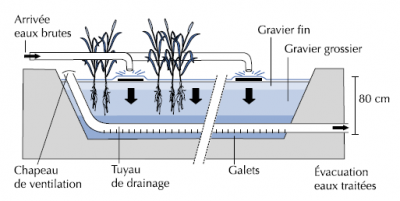Filters planted with reeds
PDF
The traditional method consists in filtering the previously degrilled wastewater through two stages of filters planted with reeds in series (1st stage with 3 filters in parallel, 2nd stage with 2 or 3 filters in parallel). Each filter is composed of a 60 to 90 cm deep filter bed (layers of gravel and sand of several granulometries) and planted with reeds (Phragmites australis, Figure 2) [1],[2]. The useful surface area required for wastewater treatment is in the order of 1 to 1.5 m2/EH [3] for the 1st floor and 0.8 to 1.2 m2/EH for the 2nd floor (Total: 2 to 2.5 m2/EH). Biological purification is carried out by the purifying biomass fixed on the filter material and on the root system of the reeds. The contribution of reeds to nitrogen and phosphorus removal and aeration is negligible. Above all, they ensure that the filters are cleaned under the action of the wind and that they are protected against freezing.

The reed filters guarantee good purification performance on the parameters MES (suspended solids), COD (chemical oxygen demand), BOD5 (biological oxygen demand over 5 days) and NK (Kjeldahl nitrogen) and a little less good on the parameters NGL (global nitrogen) and Pt (total phosphorus). The reeds are scythed (mowed and removed) every spring. The accumulation of very highly mineralized deposits on the surface of the filters on the first stage involved in the purification (pre-filter role) requires cleaning every 10 to 15 years.
References and notes
Cover image. Reeds (Phragmites australis) [Source: By Le.Loup.Gris[GFDL 1.3 (www.gnu.org/licenses/fdl-1.3.html) or CC BY-SA 3.0 (https://creativecommons.org/licenses/by-sa/3.0)], from Wikimedia Commons.]
[1] Molle P., Lienard A., Boutin C., Merlin G., Iwema A. (2004). Treatment of domestic wastewater by artificial marshes: state of the art and performance of filters planted with reeds in France, Ingénieries-EAT, special issue, 23-32.
[2] http://www.tela-botanica.org/bdtfx-nn-49047-synthese
[3] Equivalent Inhabitant. A unit of measurement used to evaluate the capacity of a wastewater treatment plant based on a quantity of pollution emitted per person per day equal to 60 g BOD5 per day. (Example: a treatment plant of 1000 p.e. receives 60 kg BOD5/day).




